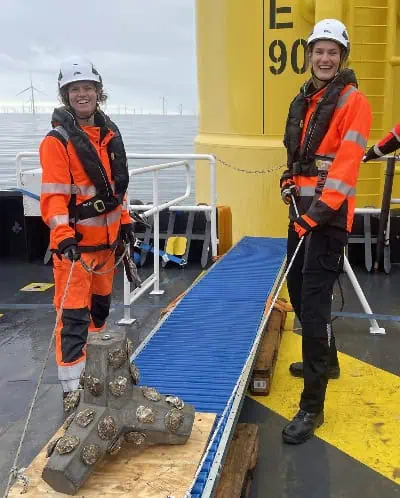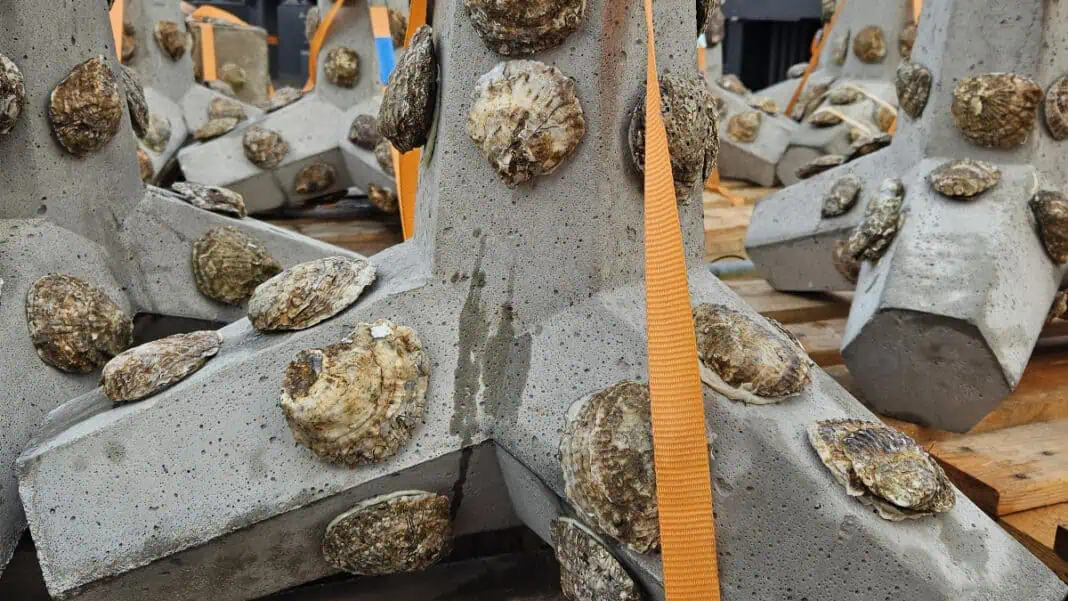Ørsted and Van Oord’s initiative Ocean Health, have installed innovative Droppable Oyster Structures in the Borssele 1&2 offshore wind farm. Droppable Oyster Structures are easily portable reef structures that have adult oysters attached to them. These oysters reproduce by producing larvae, which will then colonise and ultimately form oyster reefs in the wind farm. The new installation method is an easy and affordable way to introduce oysters on a large scale, thus contributing to biodiversity in offshore wind farms. Installation of these oyster structures marks an important milestone in Ørsted’s and Van Oord’s mission to restore the oyster population in the North Sea.
Ørsted and Van Oord have been working for quite some time to reintroduce the European flat oyster in the North Sea. Until now, oysters were deposited primarily on large, heavy oyster structures that had to be installed using a crane, a very expensive process. The partners are now testing a new and innovative concept: Droppable Oyster Structures (DOS), easily portable oyster structures that can be installed by manually placing them on the seabed from the deck of a small vessel. That means that transport and installation can be incorporated into regular maintenance activities carried out in the wind farm. The method promises to be a vast improvement in terms of ease of installation, cost-effectiveness and scalability. An underwater camera will be used to monitor the structures and oysters over time with a view to assessing the method’s effectiveness and its impact on the local ecosystem.

Some 150 years ago, roughly 20% of the Dutch North Sea seabed was covered with large-scale oyster reefs. Today, wild oyster reefs have virtually disappeared from the North Sea, along with the valuable ecosystem services that they once provided. Those services include filtration, resulting in improved water quality, and the provision of habitats, food and shelter to numerous fish and shellfish species, which promotes biodiversity.
Public authorities and conservation organisations have identified the European flat oyster as a key species in efforts to restore and improve the North Sea ecosystem. Offshore wind farms provide hard substrate and undisturbed seabed, making them highly suitable locations for restoring the flat oyster population in the North Sea. The adult oysters being introduced on the structures function as a source of larvae, which will then colonise the rock present at the site and will eventually grow into oyster reefs. This is how renewable energy and nature conservation can go hand in hand.
Karin Bilo, Senior Marine Ecologist at Ørsted: ‘The oysters were placed on the scour protection around the turbines during maintenance at the wind farm today. We’ll be using an underwater camera to check precisely where the structures have landed and how the oysters are faring. In the years ahead, we expect we’ll see the oysters slowly growing into reefs in the wind farm. This new method moves us significantly closer to meeting our goal of restoring the oyster reefs. Working with Van Oord made it possible to take an innovative concept from the drawing board to the North Sea. And that’s precisely because all of the parties involved are determined to speed up the process of restoring nature in the North Sea.’
Nienke Oostenbrink, Product Owner Ocean Health at Van Oord: ‘We are pleased to join forces with Ørsted and proud of this important step in our shared ambition to bring the European flat oyster back to the North Sea. With this innovative pilot in offshore wind farm Borssele 1&2, we are gathering valuable insights into the effectiveness of this recovery method and its scaling-up potential. Offshore wind farms offer opportunities for creation and restoration of marine ecosystems, which is why we are developing and testing efficient and effective solutions for biodiversity restoration in these areas, with which we can make an impact on a large scale in European seas.’












